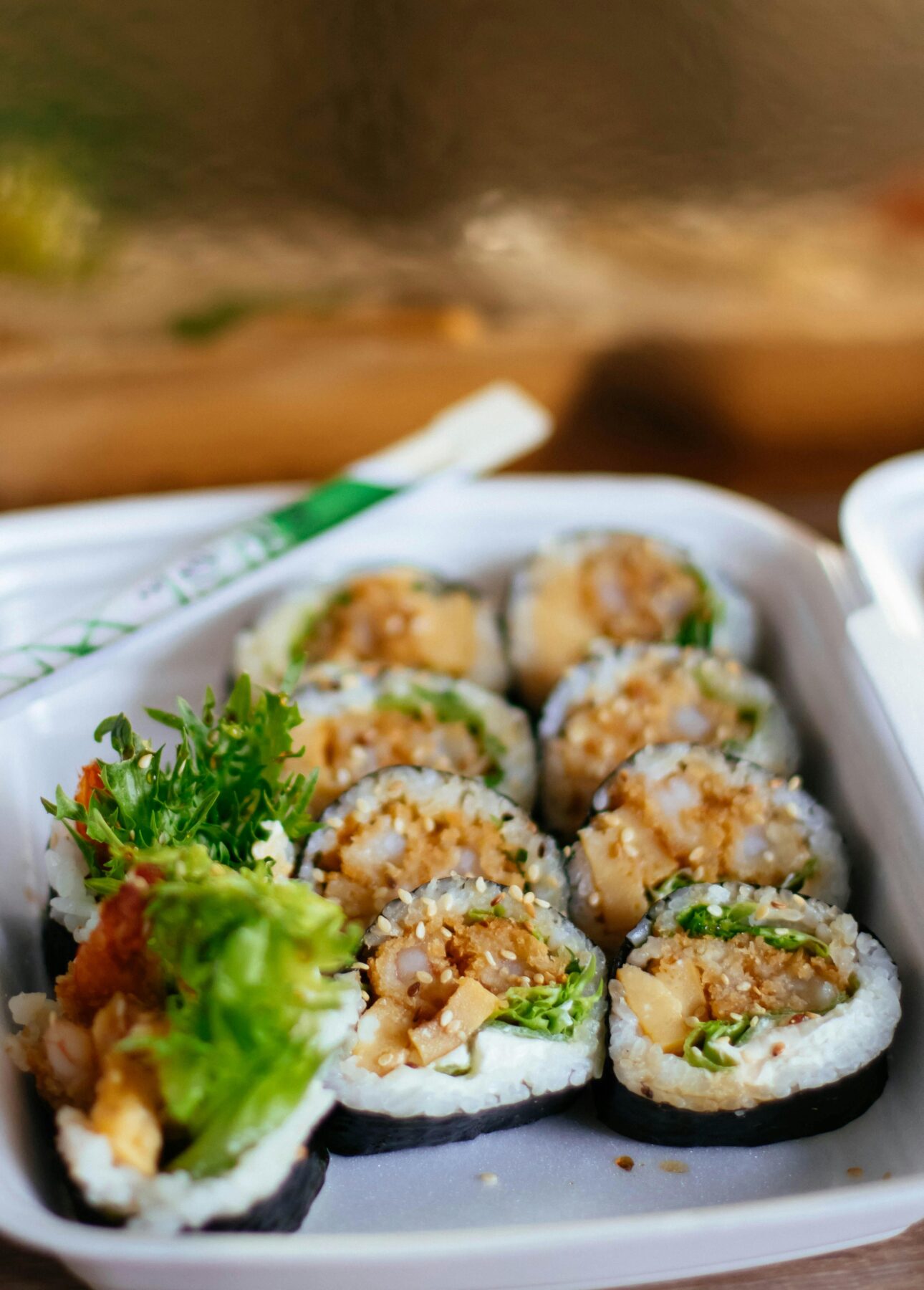Last Updated on January 23, 2025 by Karen
Learn how long leftover sushi rice and seasoned sushi rice last in the fridge, along with tips on how to properly store and reheat them to maintain freshness and flavor.

Sushi is one of my favorite foods! But as a sushi lover, you might occasionally end up with leftover sushi. Whether it’s a California roll, spicy tuna roll, Alaska roll, or sushi made with raw fish, it’s important for all you sushi lovers to understand the proper storage methods to ensure food safety and avoid the risk of foodborne illnesses.
In this post, we’ll go over the shelf life of sushi, how long leftover sushi lasts, the best practices for sushi storage time, and how to avoid bacterial growth and other health risks.
Can You Eat Leftover Sushi?
Yes, you can eat leftover sushi, but it’s important to follow the best practices for storage to maintain its safety. Raw sushi, especially those with raw fish like tuna or salmon in spicy tuna roll, should be eaten within a couple of days from bring home from sushi restaurants to reduce the risk of food poisoning. While sushi made with raw seafood has a shorter shelf life, the good news is that cooked sushi like California roll (or any rolls of imitation crab) or vegetarian sushi rolls can last a bit longer.
The key is ensuring proper storage by removing the sushi from the takeout boxes that the food establishment has put them in, and wrapping your sushi in plastic wrap or placing it in an airtight container to keep out moisture and air.
Err on the side of caution if you’ve left sushi at room temperature for more than two hours, it’s not safe to eat, as bacteria grow rapidly in the danger zone (40°F to 140°F). When in doubt, throw it out!

How Long Does Leftover Sushi Last in the Fridge?
The length of storage for sushi in the fridge varies depending on the type of sushi. Raw fish sushi, like those found in a sushi restaurant, should ideally be eaten the next day, within 24 hours. Sushi containing raw seafood is more perishable due to the increased risk of bacterial growth, so following the FDA guidelines and consuming sushi within a day is the best practice.
Cooked sushi maki rolls, such as those made with imitation crab (like in a California roll) or cooked shrimp, can last up to 48 hours. Store sushi in an airtight container or tightly wrap it with plastic wrap to preserve freshness. To maintain quality, refrigerate your sushi promptly after purchase or preparation to prevent any health risks associated with the expiration date of fresh fish.
How To Keep Sushi Fresh Overnight?
To keep sushi fresh overnight, follow these tips:
Refrigerate properly: Wrap the sushi tightly in plastic wrap to prevent air exposure, then place it in an airtight container. This helps preserve freshness and prevents drying out.
Store fish separately: If you have sushi with raw fish, it’s best to store the fish separately from the rice. Raw fish is highly perishable, and separating them helps maintain its quality.
Avoid refrigeration for long periods: Sushi is best consumed as fresh as possible. If you need to store it, try to eat it within 24 hours. Raw fish may not hold up well overnight.
Cover with a damp cloth: For the rice, you can place a damp paper towel over it to help retain moisture and prevent it from drying out.
Keep in mind that sushi is typically best enjoyed fresh, so its texture and taste may not be the same the next day.
How Can You Tell If Leftover Sushi Has Gone Bad?
The best way to determine if sushi has gone bad is by inspecting its smell, appearance, and texture. Sushi with raw fish can develop a pungent odor or show signs of discoloration, indicating that the raw fish is no longer safe to eat. Sushi with fresh ingredients like avocado might turn brown or soggy in the case of cucumber.
If you notice any signs of mold or if the rice has become slimy or overly dry, it’s a sign that the sushi has exceeded its shelf life. Day-old sushi may not have the same fresh sushi taste or texture, especially if the rice has absorbed moisture or the seaweed has become soggy. Leftover rice can also be a breeding ground for bacteria if not stored properly, which could lead to foodborne illness.

How Should You Store Leftover Sushi?
The best way to store leftover sushi is to follow specific storage measures to keep it as fresh as possible. For sushi containing raw fish or seafood, wrap it tightly in plastic wrap or place it in an airtight container to minimize air exposure, which can accelerate bacterial growth. If you’re storing a sushi roll like a spicy tuna roll or grocery store sushi, it’s also essential to place it in the fridge as soon as possible. The sushi storage time should not exceed a couple of days, even in refrigerated conditions. Keep your fridge temperature at 40°F (4°C) or lower, and don’t leave your sushi at room temperature for extended periods to avoid crossing into the “danger zone” where bacteria can thrive.
Can You Freeze Leftover Sushi?
Freezing leftover sushi is not recommended, especially for sushi with raw fish. Freezing raw sushi can alter the texture and flavor of the fish, and while the sushi may still be safe to eat, the overall sushi tastes may be compromised. For sushi containing cooked ingredients (like rolls with cooked shrimp or crab), freezing is more of a game changer. However, the texture of the rice may still degrade, and sushi will not retain its original quality. If you must freeze sushi, wrap it securely in moisture-proof paper or aluminum foil and store it in a freezer-safe airtight container. Remember, raw fish and raw seafood have a shorter shelf life than cooked sushi, and freezing will not extend this significantly.

How Long Does Seasoned Leftover Sushi Rice Last In The Fridge?
Seasoned sushi rice, which is mixed with vinegar, sugar, and salt, typically lasts 1 to 2 days in the refrigerator if stored properly in an airtight container. The acidity from the vinegar can help preserve it slightly longer than plain rice, but it’s still best to consume it within this timeframe for the best flavor and texture. Be sure to cool it to room temperature before refrigerating to avoid moisture buildup. If you need to keep it longer, freezing can be an option, but the texture may change upon thawing and reheating.
How Do You Store Leftover Sushi Rice?
If you are making sushi at home and have extra sushi rice, you can save them for next meal. They are perfect as a base for poke bowls! To store leftover sushi rice, follow these steps:
Cool the rice: Let the sushi rice cool down to room temperature before storing it. Avoid putting hot rice directly in the fridge as it can create condensation and affect the texture.
Transfer to an airtight container: Once cooled, transfer the rice to an airtight container to prevent it from drying out or absorbing other odors in the fridge.
Cover with a damp cloth (optional): If you want to keep the rice moist, you can place a damp paper towel over the rice before sealing the container. This will help retain some moisture.
Refrigerate: Store the container in the fridge. Sushi rice will stay good for 3 to 4 days.
To reheat, sprinkle a little water over the rice, then cover and microwave it for 20-30 seconds to help restore some moisture and make it soft again.
How Do You Reheat Leftover Sushi Rice?
Whenever we make sushi at home, I’ll always make a little extra seasoned sushi rice for lunch the next day. Our kids love them plain wrapped in seaweed (quick onigiri) or I’ll make some musubi with spam and eggs.
To reheat seasoned sushi rice, follow these steps to restore its texture and flavor:
Method 1: Microwave
- Place rice in a microwave-safe bowl: Break up any clumps to ensure even heating.
- Add moisture: Sprinkle a little water over the rice (about 1-2 tablespoons per cup of rice) to prevent it from drying out.
- Cover with a damp paper towel or microwave-safe lid: This helps to trap moisture and steam the rice.
- Reheat: Microwave in 30-second intervals, stirring between each interval, until the rice is hot and fluffy. Be cautious not to overheat.
Method 2: Stovetop (Steaming)
- Place the rice in a saucepan or steamer: Add a small amount of water (about 1-2 tablespoons) to the rice.
- Cover with a lid: Make sure the pan is tightly covered to trap steam.
- Steam: Heat on low to medium heat for about 5-10 minutes, stirring occasionally. You can also place a wet paper towel between the pot and the lid to keep the rice moist.
- Either of these methods will help maintain the rice’s moisture and prevent it from becoming too dry or hard. If the rice still feels too dry after reheating, you can lightly sprinkle a little more vinegar-water mixture over it to bring back some of its original flavor.
What Are the Risks of Eating Leftover Sushi?
The primary risk of eating leftover sushi, especially raw sushi, is the potential for foodborne illness caused by bacterial growth or improper storage. Raw fish, when not stored properly, can lead to serious health issues such as food poisoning due to bacteria like Salmonella or Vibrio. Raw fish and seafood have a higher risk of harboring harmful bacteria, and improper storage at room temperature can increase the risk of foodborne illnesses. It’s important to always follow safety guidelines for sushi storage, and if in doubt, throw away any sushi that looks, smells, or tastes off. For safety, adhere to the FDA food code and food safety plan guidelines to minimize risk, especially for young children and individuals with weakened immune systems.

How Do You Reheat Sushi?
Reheating sushi can be tricky, especially since raw fish doesn’t reheat well. However, if you’re just dealing with leftover sushi rolls (without raw fish) or sushi rice, here are some methods:
For Sushi Rolls (without raw fish):
- Remove the fish (if present): If your sushi contains raw fish, it’s best to discard the fish as it won’t hold up well after being reheated. You can save the rice and veggies for later use.
- Microwave method:
- Wrap the sushi in a damp paper towel to keep it from drying out.
- Place it in the microwave for 10-15 seconds. Be careful not to overheat it, as it will change the texture of the rice.
- Steam method (better for preserving texture):
- You can lightly steam sushi rolls to warm the rice without losing too much moisture.
- Place a damp towel over the rolls, and steam them for a few minutes on low heat.
For Sushi Rice:
- Microwave: Sprinkle a little water over the sushi rice, cover with a damp paper towel, and microwave for 20-30 seconds.
- Stovetop: Place the rice in a pan with a tiny bit of water (just enough to create steam) and heat on low while stirring occasionally.
Keep in mind, sushi is best enjoyed fresh, so reheating will affect the quality, especially for the fish!

Can You Eat Leftover Sushi from a Grocery Store?
While store-bought sushi from the grocery store can be convenient, it should be consumed with caution if you have leftovers. Store-bought sushi is usually made with fresh ingredients, but it doesn’t always have the same level of freshness as sushi from a high-quality sushi restaurant. The sushi storage time may vary depending on how the store has stored it. Always check the expiration date and keep the sushi in an airtight container in the fridge. Ideally, you should eat grocery store sushi the next day to avoid any food safety risks associated with raw fish or seafood.
Leftover sushi can be enjoyed safely if you follow specific storage guidelines and consider the type of sushi you have. Raw sushi made with fresh fish or raw seafood should be consumed within 24 hours, while cooked sushi may last a bit longer. Always store sushi in an airtight container or wrap it tightly in plastic wrap, and keep it refrigerated. By adhering to the best practices for sushi storage and following food safety guidelines, you can enjoy your sushi leftovers without the risk of foodborne illness.
Have more questions about sushi leftovers or need more tips on proper sushi storage? Leave a comment below!















